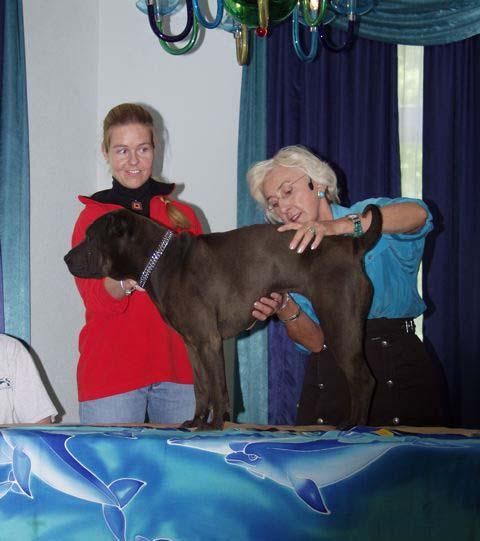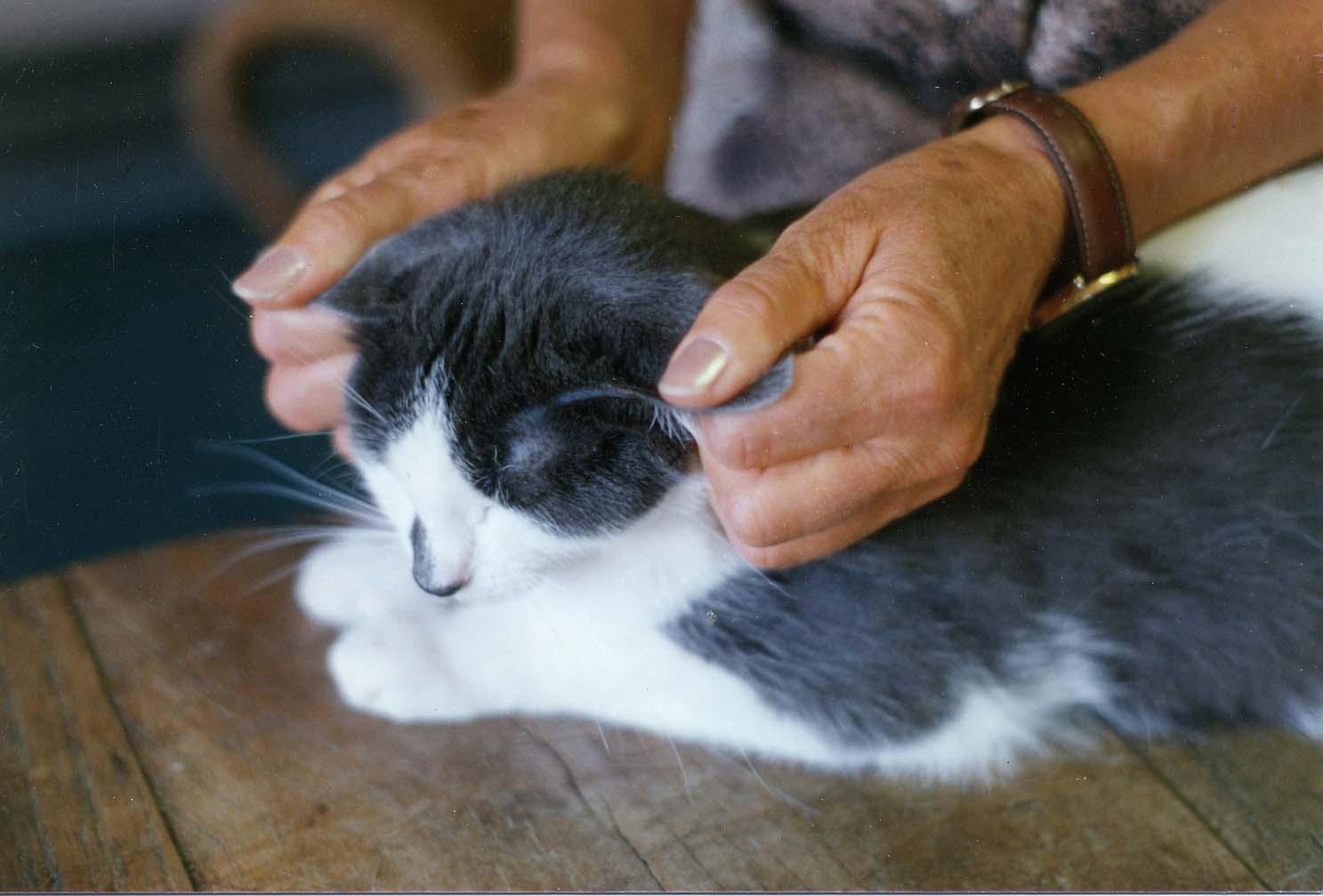
Tellington TTouch Training (TTouch), was developed by internationally-recognized animal expert Linda Tellington-Jones. It Is a “specialized approach to the care and training of our companion animals, horses and exotic animals, as well as for the physical and emotional well-being of humans.”
Although hard to describe on paper, TTouch at its most basic, is a series of touches, lifts and slides that will “improve behavior, enhance performance and health and teach a dog to learn willingly.”
The below video explains a “basic TTouch.”
For an in-depth look, you can watch Tellington-Jones 26-minute video here.
Judi Truskey became a Certified TTouch Practitioner in 1999 after initially learning TTouch Training techniques to help her own dog. She left the corporate world in 2006 to focus on working with people and their dogs. In addition to providing private TTouch sessions, she teaches workshops and classes and incorporates TTouch into her work with warm water swimming for dogs. Judi works in the Portland, Oregon and Vancouver, Washington area.
We asked her a few questions about how TTouch can help your dog be a better canine companion.
How does TTouch work?
JT: TTouch works by working with animals in nonhabitual ways. When we use the TTouches, we are touching dogs in ways that are different from how we usually pet or groom them. Their bodies pay more attention because these are new touches, and this opens the possibility for our dogs to change the way they use their bodies or their attitudes toward surroundings or situations. The bodywraps and other awareness aids similarly help dogs get in touch with how they move their bodies. When we do TTouch groundwork, in the Playground of Higher Learning™, we ask dogs to move slowly so they can notice how they are using their bodies – much like we are far more aware of our balance when riding a bicycle slowly than when we ride it more quickly.
What are some of the tools used (you had mentioned a wrap?) and what are they used for?
JT: Commonly used tools in TTouch include people’s hands (for the bodywork aspect); bodywraps (stretchy elastic strips which we put on the animals to help them become more aware of their bodies); and harnesses and double-ended leashes. The harness-and-leash configurations we use to help teach our dogs how they are moving and to improve their cooperative walking skills.
In Dogs, What is it used for primarily?
JT: We use TTouch with dogs for a wide variety of things ranging from mouthiness and motion sickness to easing the pain of arthritic joints and learning how to effectively use their bodies. Like us, dogs’ bodies often reflect their mental and emotional state, so changing how the body feels can be very helpful for changing the mental and emotional outlook.
People often use TTouch with their dogs for its calming and relaxing aspects. We can help a dog reach and maintain a calm, relaxed emotional state that makes focusing on learning or performing much easier.
We also use TTouch for dogs who are uncomfortable being away from their owners or who are reactive to people or other animals.
The TTouch work also is used for bonding and working together cooperatively because we observe our dogs’ reactions to the work and adjust accordingly. If a dog feels something about the work is too much, we will back off a bit to let the dog know we’re paying attention and respecting her ability to communicate. We may then work where she is more comfortable before asking her to trust us as we try to do a bit more. As our dogs begin to trust us more, the bond between us deepens.
It is important to remember that TTouch is not a substitute for veterinary care. Neither is it massage. The TTouch touches look superficially like massage, but they are designed to move the skin and bring the cellular awareness rather than relax muscles like massage does.
What kinds of dog’s benefit from TTouch?
JT: Many kinds of dogs benefit from TTouch. It’s often used for dogs who lack confidence. TTouch seems to help dogs become aware of where they are in space (many dogs are not fully aware of their bodies) and that allows the dog to start relaxing about external stimuli. It can be useful for dogs who tend toward separation anxiety or reactivity toward other animals. We often use TTouch with puppies who are mouthy or prone to carsickness. With older dogs we may use it to help recovery from an injury or to ease the discomfort of arthritis or similar aging challenges. With dogs in the prime of life, we may use TTouch as preparation for training or competing, to help recovery from injury or surgery, or to build confidence and reduce reactivity.
How long does the effect of a session last?
JT: How long the effects of TTouch will last (and even what form they will take) varies from dog to dog. With something like mouthiness, that may take some work over a relatively short amount of time. Confidence building is highly variable, but often people will work with it over a few weeks or months, perhaps returning to the TTouch work if another stressful situation comes up for the dog. Aging dogs may receive TTouch for the rest of their lives.
How simple is it to learn?
We say TTouch is simple but not easy. The basic TTouch is called the Clouded Leopard Touch [demonstrated in the video above].
Many of the other TTouches are variations on this touch, varying mostly in how much of the hand is touching the dog. We also have non-circular touches which can be used to relax the body or help integrate both sides of the body.
The bodywraps are flexible in their use and application so are easy to use. They need to be removed if the dog is going to be left unattended. The groundwork can be easy or challenging.
One of the most versatile tools for groundwork is also the easiest to use. That is the Balance Leash, which uses the everyday leash looped in front of the dog to help reduce pulling. A video can be found here.
A Few Examples
TAIL TTOUCH

EAR TTOUCH

Want to Learn More?
After speaking with Judi one thing was clear, my sheltie and I would be signing up for TTouch! If you are interested in learning more, you can see her website, or the main TTouch website. Books, videos and equipment are available at the main TTouch site, as well as a list of Practitioners worldwide.
About the Author
Based in Wilsonville, Ore., animal lover Kristina N. Lotz is a Certified Professional Dog Trainer – Knowledge Assessed (CPDT-KA) and a member of the Dog Writers Association of America. She is the founder of A Fairytail House. In her spare time, she trains and competes in a variety of performance events with her Shetland Sheepdogs and caters to her two rescue kitties. She smartly married a Veterinary Technician, who helps keep the fur kids happy and healthy, and provides a quick resource for articles.
